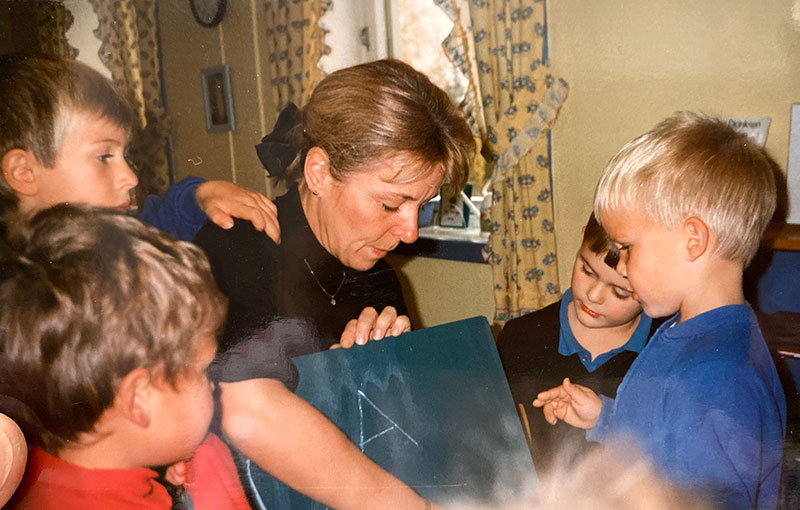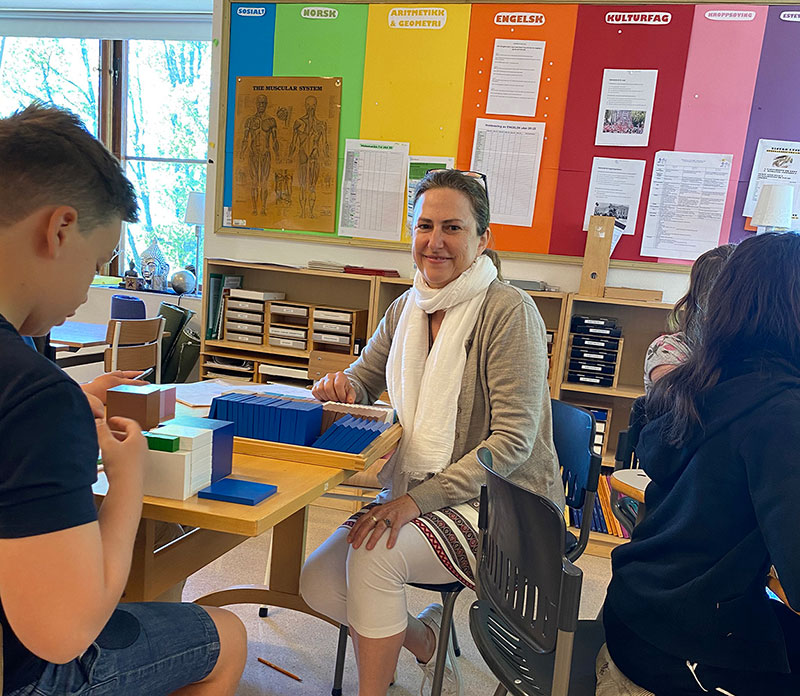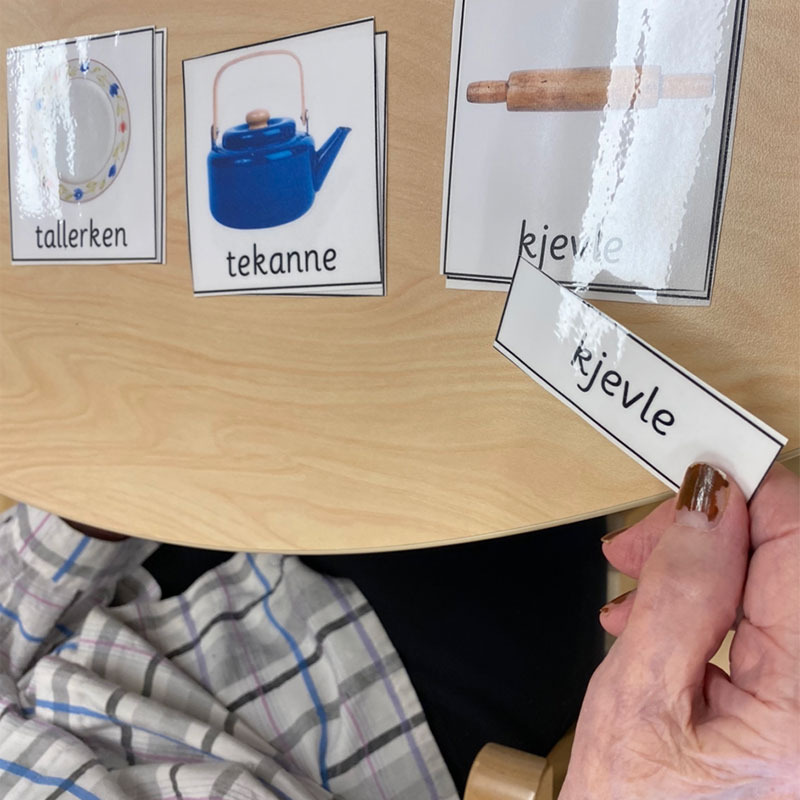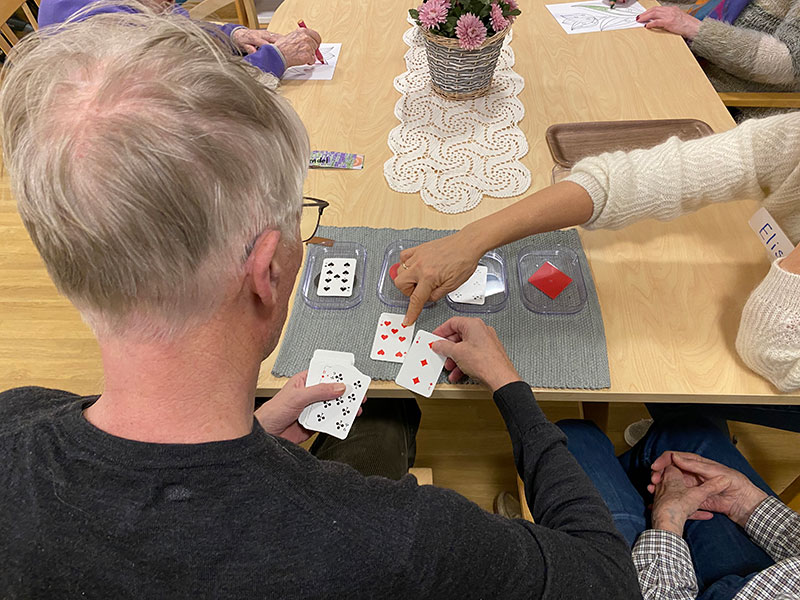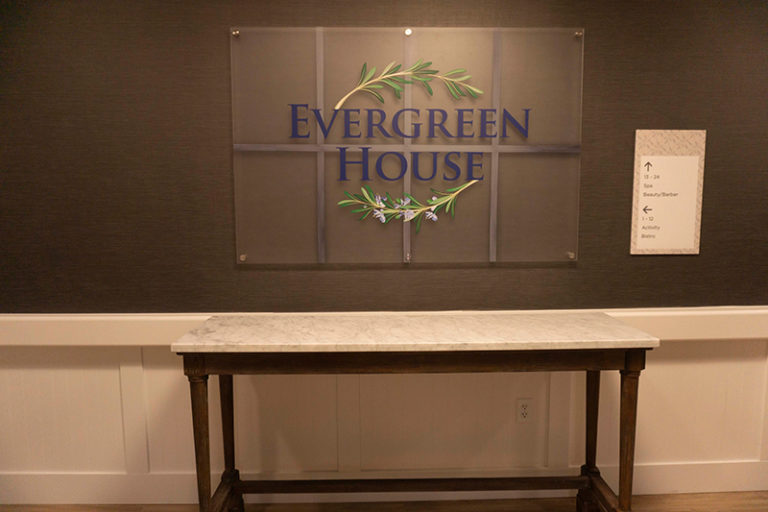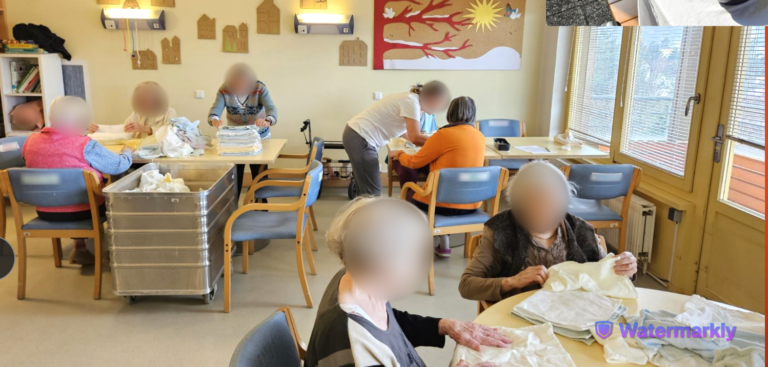Introducing Montessori for Elders in Norway
By Elisabeth Rydland and Carolyn Magnussen
(Elisabeth and Carolyn are the first AMI Certified Practitioners in Montessori for Dementia and Ageing in Norway)
Norway saw its first Montessori kindergarten over a half century ago in 1969. In the early 1990´s, Montessori elementary schools began popping up throughout the country, followed by several Montessori secondary schools. Both authors joined the Montessori movement in Norway in 1990, as Montessori teachers and Montessori parents with now over 30 years of experience with children of all ages. In 2019, we began a new journey by participating in the AMI workshop Montessori for Ageing & Dementia and then the Practitioner Certification Course, both taught by Jennifer Brush. We would like to share a new, rewarding perspective, one that provides a deeper value to the Montessori philosophy and enhances quality of life for elders and people with dementia.
Montessori said to “follow the child”. This is translated in dementia care to “knowing the person” and actively inviting the elders to tailored activities and meaningful roles which are based on their individual interests and level of functioning. Montessori is also credited for the quote “Help me to help myself”, which is directly applicable to humans of all ages. Being able to help oneself adds to agency, self-mastery and feelings of self-worth.
In early January 2020, we began our practical work at an institutional care community in Norway. We will call this institution “Pine Grove”. Visiting Pine Grove was both heartwarming and heart breaking. The heartwarming aspect was the warmth and care the staff showed the elders. However, it was heartbreaking to witness the passiveness, inactivity, and lack of meaningful activities in which the elders could engage. Although the elders were invited to participate in various group activities such as physical training, sing along visits from the kindergarten, and special lunches, these were organised activities, requiring no initiative, little choice and limited participation by the elders.
After just our first visit, we realized that applying the Montessori approach to this environment would have a huge impact in the everyday lives for both the residents and the staff. For the staff, the Montessori philosophy would be the game changer that would allow them to go from providing service to facilitating meaningful independence through roles and activities. For the residents, the Montessori approach would provide possibilities of dignifying independence, engagement in meaningful activities, maintaining skills, like reading and small motor coordination, and improved social interaction with other residents. It would also increase dignity by way of participation in everyday tasks through supported roles. And ultimately, the main goal would be adding more joy and purpose to the everyday lives of the people who live and work at Pine Grove.
Observation of the Environment
Dr. Montessori stressed the importance of observation. For our entire school careers we have keenly used the tool of observation to solve many of the challenges that presented themselves throughout the school year and to inform our work with the children. At Pine Grove, we began with observing the elderly at different times throughout the day, spanning several weeks.
The Montessori Prepared Environment is designed to specifically meet the needs and tendencies of the human at each different plane of development. What might the prepared environment look like for elders with cognitive decline? We attempted to answer this question by first observing the existing environment and the effect it had on the residents and then making suggestions to create a Montessori Prepared Environment.
The main area we observed was formed by 4 corridors that met in an ‘H’ shape. The third floor was sparsely furnished with with two couches and four big chairs. A piece of paper taped to the hall listed the activities in small print. A bulletin board contained a a jumbled array of flyers for staff. All four corridors looked exactly the same. There was nothing more than furniture and a TV set in the fluorescently lit area. The elders sat around and watched each other or walked the indiscriminate halls.
Suggestions to Prepare the Environment
After taking the AMI Montessori for Aging and Dementia course with Jennifer Brush about how to enrich the lives of elders in care communities, we had many ideas on how to improve the environment at Pine Grove. The first thing we would do would be to paint and decorate the corridors in different colours and themes and give each of the corridors its own name. One could be painted green and be named Park Lane, as it leads up to the nearby park. Another could be blue and named Ocean View, as it offers a view of the ocean through its window at its very end. This would help the elders and visitors orient and create beauty as well.
We would provide a shelf with activities tailored to the elders’ skills and interests. Appropriate reading materials could be placed throughout the area. The elders enjoyed working with us with the various materials we especially designed for them. Some of the materials we presented included:
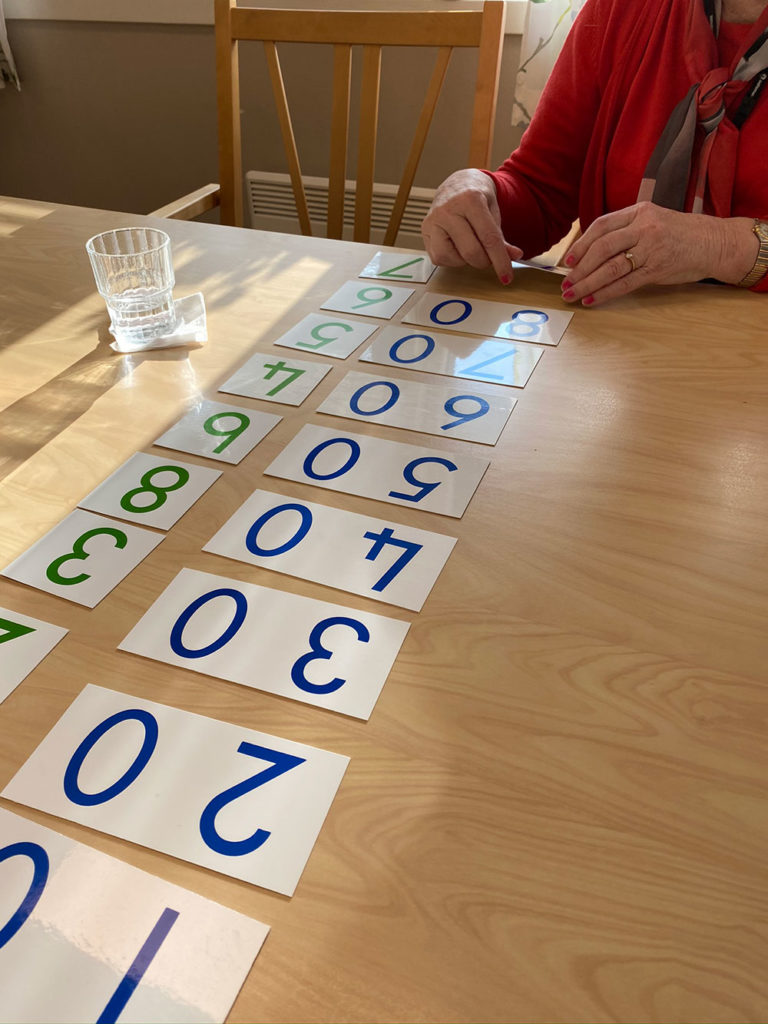
- Nomenclature cards of kitchen utensils for the baker in the group, dogs for the dog owner, horse riding gear for the horse lover.
- A sorting tray with playing cards for the Bridge enthusiast.
- Nomenclature cards about indigenous Norwegian culture for the person belonging to the Lapp people.
- Sorting vegetables for the gardener
- Wooden numeral cards for counting for the man who loved an Arabic counting game.
- English matching to Norwegian for the woman who had relatives in the U.S.
- English sentences matching to pictures of clothes for the fashionista who had worked with an international shipping company.
A door is slammed shut, but a window is opened: Getting back into Pine Grove
Because of Covid-19, the nursing home was closed for all outside visitors in March. We waited, along with the rest of the world wondering what would happen. We decided to conduct a few interviews with other care communities over the phone and it became evident that maintaining reading skills and having appropriate reading materials to offer was something of a “sore spot”.
We had an idea. We would make some reading material in large type, based on the interests of the elders with whom we had worked. As summer approached, Norway opened up at bit, and we contacted Pine Grove and asked if we could have reading circles outside on the veranda; They agreed!
We wrote six books on different topics. Our aim for these sessions were three-fold:
- To re-establish contact with the nursing home staff and elders after 5 months of quarantine.
- To gain experience creating reading circles with residents of varied skill levels and interests.
- To field test the books we wrote.
We met with two groups of elders on the first day of the reading circle. The first group, with whom we had worked in the late winter, was escorted outside to a shady patio with wicker chairs and a table. It was a lovely day with the sun shining and the trees gently moving in a light breeze. We gave the elders name tags and introduced ourselves. We dove right in, reading with the easy reader: “Letter from America” in Norwegian. They were curious about the book in front of them. Keira paged through the book ahead of the others. She started reading by herself, silently moving her lips with audible words now and then. They were polite, but not that interested in the book.
The second group of three women were functioning at a higher level. Laura kept paging ahead and it was hard to tell if the other two women actually understood what they were reading. The challenge of working with adults with dementia is that, while so much knowledge may be missing, so much also remains. Finding out where to begin can be tricky because while we don’t want to insult them with too low of a level, we also want to meet them where they are, and to spark “the point of interest”. Luckily, we had some songs to sing, which they all enjoyed, when some of our books fell flat.
We headed home and made nomenclature material to match the books. When we transformed the sentences in the books into riddles, the magic occurred. One woman with very little expressive language, Laura, had been nervously pressing her alarm button and standing up to leave on the first day. When we presented the riddle cards on the next day, she came to life! She loved the riddles and eagerly responded to them by finding the matching picture card, smiling every time.
Another popular activity which they succeeded at and greatly enjoyed were idioms. We read the beginning and they eagerly offered the ending. “An apple a day…keeps the doctor away”. The idioms and the songs are a wonderful and safe way to start a session which gives the guide time to observe engagement and level of abilities.
Although we began straight off with the books, our experience with these groups made it clear to us that we needed to provide reading materials on the same theme at several different levels ranging from word cards to the whole book. The Montessori Three Period Lesson and Nomenclature cards, are a good place to start to ensure that the residents recognise the pictures and are able to read the word cards and make the match.
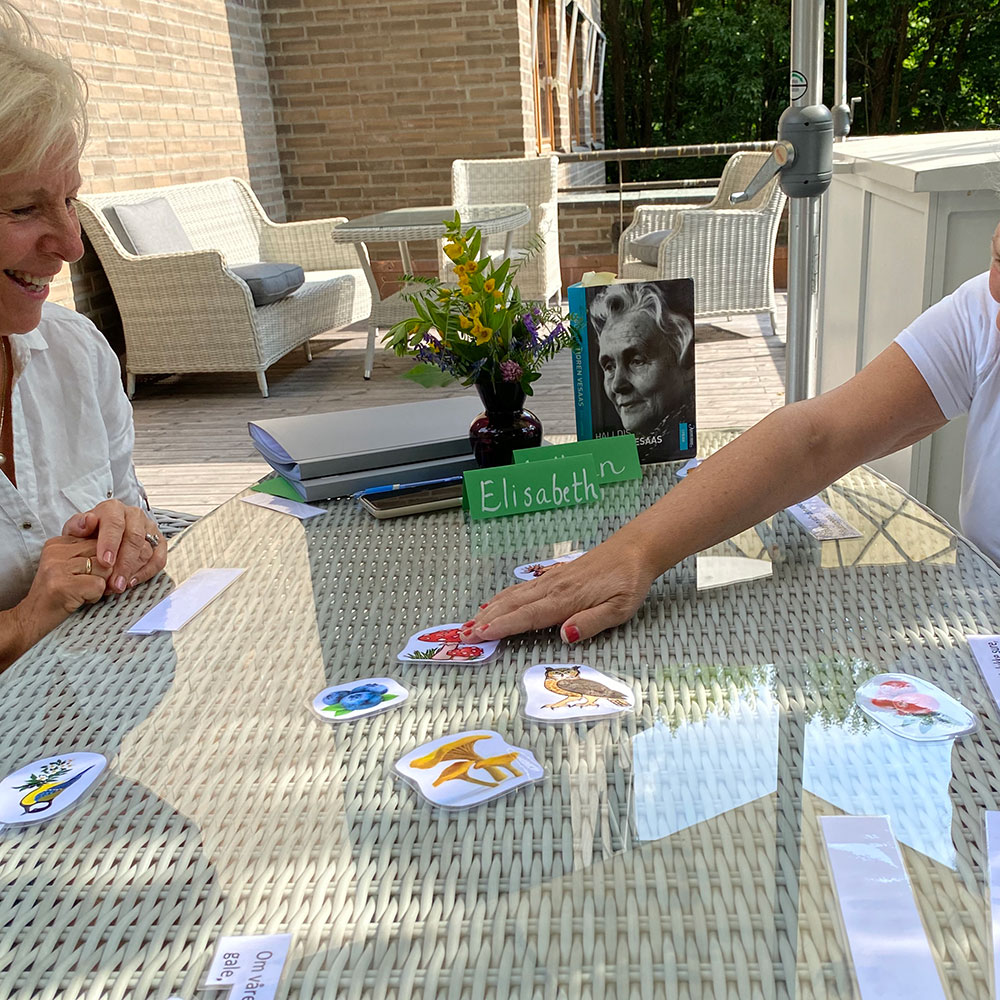
In one special incident we had a man who had a severe osteoporosis and could only look down. In his case we would make floor charts and written and pictorial trails on the floor for him to read, follow and enjoy. The Montessori philosophy inspires rethinking new ways to connect a person of any age or ability level to the community and to meaningful engagement to the world around them, a world in which they can thrive and flourish.
We are highly motivated to continue our work with enriching the lives of older adults. We extend our deep gratitude to Jennifer Brush & Margaret Jarrell from Brush Development, Association Montessori Internationale, and the great change maker, Maria Montessori, for their work at improving the whole lives of people. We are honoured to bring this important work to Norway.


